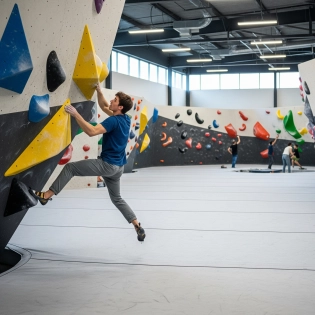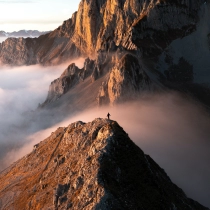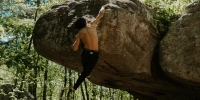
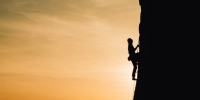
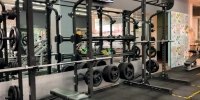
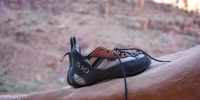




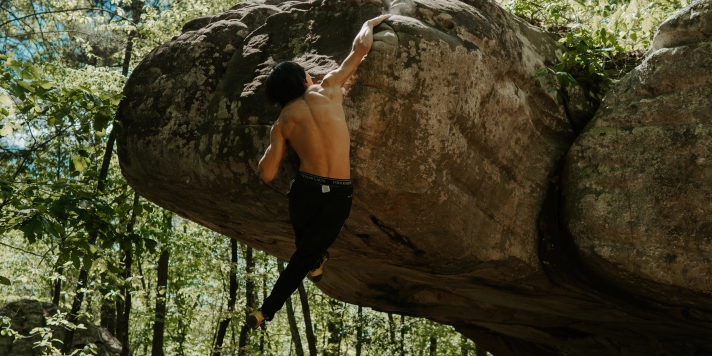
bouldering
The duration of a bouldering session can vary depending on factors such as personal fitness, climbing experience, and individual preferences. Generally, a bouldering session can last anywhere from 1 to 3 hours. This duration allows for an effective workout while avoiding excessive fatigue or overexertion. It's important to listen to your body and take breaks as needed during the session to prevent injury and maintain energy levels. Some climbers may prefer shorter, intense sessions, while others may enjoy longer sessions with more rest periods in between attempts.
You can wear glasses while bouldering, and many climbers choose to do so. It's important to ensure that your glasses fit securely on your face to prevent them from slipping or falling off during dynamic movements. Using a sports strap or retainer can help keep your glasses in place. Additionally, consider wearing glasses with impact-resistant lenses or exploring options for protective eyewear to keep your eyes safe during close contact with the rock. Keep in mind that climbing can be a physically demanding activity, and your glasses may fog up due to perspiration. To minimize fogging, you can use anti-fog wipes or sprays. If wearing glasses becomes too cumbersome, you may also consider using contact lenses as an alternative. Ultimately, find the option that provides the best balance of comfort, vision, and safety for your bouldering sessions.
Yes, you can lift weights and boulder on the same day. Start with bouldering and leave weightlifting for later in the day. Allow a few hours between the activities to recover. Warm up before each session and cool down afterward. Listen to your body and adjust the intensity if needed.
Yes you can lift weights and boulder on the same day, you just need to be very cautious and listen to your body otherwise you can get injured very quickly. This is especially true if you are new to either bouldering or weight lifting, your muscles and tendons are still adapting and adding extra load to it all can just increase the risk of injury be quite a bit.
If you do, just allow yourself enough rest in between sessions, or, don't max out on both sessions.
As you scale up the climbing grades, progressing from one grade to the next will be more difficult for each new grade. It makes sense that reaching and climbing v9s consistently will be harder and take longer than it did for you to reach the v8s. The same will be for when you want to go from v9 to v10.
If there is a certain project you are working on, try to understand what you are not succeeding in. If it's a specific move, try to practice and train for that specific move until you can do it on the actual route. If it's a difficult hold or body position, train specifically for that.
The point is to break up the route into smaller pieces and to work those out until you can do them on the route itself.
If you can do all of the moves, but have difficulty putting them all together and doing the whole route, try to do it in sections. Try doing half of the route from the start, and the second half from the middle till the end. Or, if there is a specific point that is difficult, try doing the route until that point from the beginning, and then from that point until the end.
Another option is to work a small section with that just point in the middle, so that you are working on that difficult point specifically.
The point with this is to try and improve the moves that you are currently able to do, and to figure out different options for the moves that are difficult.

Climbers don't wear gloves while bouldering, sport climbing, or any other type of rock climbing, with the exception of crack climbing in which the climber may wear a special kind of glove that covers the back part of the hand, leaving the palm uncovered.
Climbers don't usually wear gloves because gloves reduce the friction between the climbing holds and the climbers hands. In very easy and beginner level climbing, this may not be so important, but for later on it will be crucial and could prevent climbers from holding certain holds.
Some holds require a large amount of friction, otherwise you can just slip right off. Wearing gloves, even those that cover only the palm and leave the fingers exposed, reduces that much-needed friction way too much. This is also why crack climbing gloves cover only the back side of the hand, and not the palm. Crack climbers still use their fingers and palms for climbing, so they must be exposed and not covered. The back side of their hands are covered up to help reduce pain and injuries from the pressure of their hands against the cracks.
Here are 6 exercises and tips that I use that have helped me climb better and get better at bouldering:
1. Slow and Quiet Climbing
This is probably one of my favorite exercises, and one I do every time I go climbing as a warm-up, and as I finish climbing.
What you do is you simply climb easier routes, but quietly. If you make any sound at all (not including clicking sounds from fingers or legs, or sounds from the shoes such as the rubber or the Velcro), you get off the route, and start the route over again.
What this does is it teaches you to be more precise with your movements and hand and foot placements, as you have to really grab the hold slowly and softly to not make a sound.
It strengthens your muscles because as you climb slowly, you will find yourself in more lock-off positions, where you are holding your body weight with more of your muscles.
It's a great warm-up when doing it on easier routes, and is great for some extra low intensity climbing at the end of the session, but, it's also a great exercise to keep in mind while climbing difficult routes also, as the precision in the movements and limb placements can really make a huge difference in the harder routes.
It's a great exercise to really give your technique a boost.
2. Moonboarding or other tension boards
Strength may not necessarily be more important than technique, but it is important. Grip strength, finger strength, and pinch strength are crucial for climbing harder routes, especially for overhanging routes.
Grip and pinch strength can be trained in isolation with punch blocks and other gear, but one of the best ways I have found to increase my strength, and not just in my hands, is the moon board. It is also much more interesting than just lifting a block of wood for a few seconds as you are actually climbing. It also strengthens your core, shoulders, back, and other muscles in addition to just grip strength.
If you have a moonboard or any kind of tension board, I highly recommend dedicating a session or two per week to climbing only on it. After even just a month, you should be able to see the difference in your strength.
3. Projecting
Many climbers choose to only climb routes that are around their climbing level. This could be out of comfort, or out of the idea that they just can't climb harder routes because they are not there yet.
Climbing routes that are above your climbing grade can actually be one of the best things you can do for your climbing.
First of all, you may actually be surprised and may be able to climb the harder routes.
If not, even if you work on the route and get just a few movements in, those movements can go a long way in improving your overall climbing abilities, knowledge, and experience.
Plus, when you actually finish the route, the amount of motivation you will feel will be unmatched, a perfect dose for climbing harder and choosing another project.
4. Strength training
As mentioned, strength training is very important. Not just finger strength, but general body strength. This includes the back, shoulders, arms, chest, core, and legs.
Also, training antagonist muscles is very important as it can help prevent injuries due to imbalances and poor posture.
I would add a few weight lifting or body weight training days to your climbing schedule, to make sure that you are giving your whole body a proper workout.
5. Feet work
Most beginner climbers don't understand the importance of feet work. They think it's just an upper body sport, mainly for the back and arms.
This is very far from the truth, as feet work can be the defining element between success and failure on a route. You can be as powerful and as strong as you want, but if you have poor footwork, everything will just be that much harder for you.
Climbers who are not very strong often times climb better than those who are because they have much better technique and foot work. They cannot rely on their strength since they don't have that much, so they climb with increasingly better technique.
6. Flexibility
I have seen flexibility being the element that allowed some climbers to send their projects. It is underestimated in importance. People either think it is not that important, or, they just don't want to do it because they don't like it.
This is unfortunate, because being flexible just gives you that extra advantage on the wall, and on the routes where strength is just not enough.



